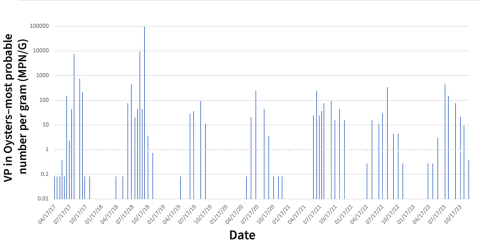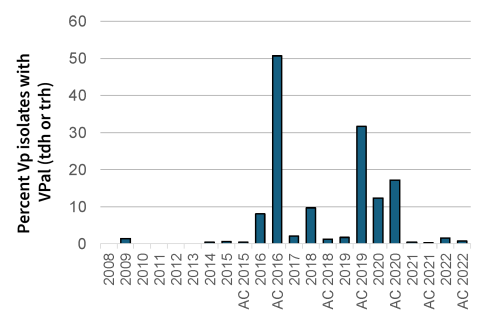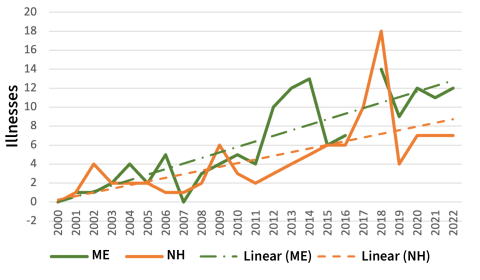This research was published in the INSPIRED: A Publication of the New Hampshire Agricultural Experiment Station (Fall 2024)
Researchers: S. H. Jones and C. A. Whistler
In the past decade, pathogenic variants of Vibrio parahaemolyticus have increased in Northeast aquaculture areas, bringing increased risks of human illnesses related to shellfish consumption. Though increasing ocean temperatures and the rapid expansion of regional oyster aquaculture have likely contributed to increases in disease from local sources, the introduction and establishment of a Pacific lineage of Vibrio parahaemolyticus sequence type (ST) 36 in the region is arguably the biggest driver of disease. Even as New Hampshire aquaculture has expanded in recent years, the invasive pathogens have not yet been linked to local products, nor have they been detected in growing production areas. Yet the northward expansion of pathogenic populations remains a serious concern, and it is important to understand factors that promote pathogen invasiveness and resilience.
Methodology
Field Sampling and Lab Analyses:
A collection of samples of oysters, sediment, water, phytoplankton, and zooplankton allowed temporal and spatial analyses of Vibrio parahaemolyticus concentrations and population traits, including the presence of gene content that confers human virulence (hemolysins tdh and trh) from the Great Bay Estuary. Methods similar to those used by the U.S. Food and Drug Administration were used to track this potential pathogen in oysters. Existing methods were optimized, and new analytical approaches were developed to identify distinctive genetic markers in assays to track different strains of pathogenic Vibrio parahaemolyticus, including regionally hypervirulent strains.

Fig. 1. Vibrio parahaemolyticus concentration in NH oysters sampled from Nannie Island 2017–2023.
Temporal Analysis and Predictive Modeling:
A range of ecosystem conditions has been consistently tracked in water samples, including pH, dissolved oxygen, salinity, concentrations of Vibrio parahaemolyticus, nutrients, solids and plankton, and types of plankton over 18 years at two sites. A combination of descriptive and predictive modeling and multivariate community analysis representing sites and the harvest area was used to analyze Vibrio parahaemolyticus concentrations in oysters. This resulted in the identification of pH, temperature, and plankton communities as drivers of Vibrio parahaemolyticus concentration variation.
Key Findings
- The prevalence of Vibrio parahaemolyticus strains with human pathogenic potential in Great Bay Estuary oysters shifted from rare to common by 2020, and then declined.
- An 18-year database analysis identified pH, temperature, and plankton communities as key factors driving fluctuations in Vibrio parahaemolyticus concentrations, peaking in 2007–2016 and declining in 2018–2023.
- The invasive Vibrio parahaemolyticus strain causing increased illness in New England has not been detected in New Hampshire aquaculture, emphasizing the need for locally based monitoring rather than reliance on regional data.
About the Co-authors

Cheryl Whistler, Professor of Molecular, Cellular, and Biomedical Sciences
Contact information: Cheryl.Whistler@unh.edu, FindScholars profile

Stephen Jones, Research Associate Professor of Natural Resources and the Environment
Contact information: Stephen.Jones@unh.edu, FindScholars profile
Discussion of Findings
Temporal analyses and comparisons of archived environmental isolates with isolates from clinical sources helped the researchers to better understand how pathogenic lineages emerge from local reservoirs. Overall, Vibrio parahaemolyticus concentration in New Hampshire oysters has declined since 2017, remaining relatively consistent at the lower level in 2019–2023, with concentrations peaking in the summer months (Fig. 1).

Fig. 2. The percent of Vibrio parahaemolyticus isolates with pathogenic markers (tdh; trh) found in wild or aquacultured (AC) Great Bay Estuary, New Hampshire oyster sites in 2008–2022.
The endemic Northeast population of Vibrio parahaemolyticus is genetically distinctive, as are the prevalent virulence determinants compared to pandemic and Asian strains, which cause most infections worldwide. Since its peak in 2016, the presence of pathogenic markers in New Hampshire oysters indicating genes that confer human virulence has decreased substantially (Fig. 2). This may explain why there are fewer reported human illnesses due to Vibrio parahaemolyticus in New Hampshire than in Maine, and no cases have been traced to commercial products from New Hampshire (Fig. 3).

Fig. 3. Number of reported Vibrio parahaemolyticus related illnesses from 2000–2022 in Maine (ME) and New Hampshire (NH) with linear trend lines.
Ancestral and geographic patterns and mapping virulence determinants upon lineages indicate that more recent emergent pathogens in the Northeast most often were either related to Pacific endemic lineages or acquired virulence gene content via genetic exchange with these invasive lineages. This helped the research team develop sensitive tracking tools for genetic elements associated with virulence and enabled them to study the ecological interactions that may contribute to enhanced survival of pathogens, including resistance to phage and protist predation.
Strategic Recommendations and Conclusion
The prevalence of Vibrio parahaemolyticus in Great Bay has decreased since peaking in 2017, corresponding with a broader decline in regional vibriosis cases. Notably, the absence of the invasive Pacific-native strain in New Hampshire’s aquaculture areas, despite its presence in Massachusetts, highlights a key distinction for local risk management. Ongoing monitoring and mitigation strategies should be based in state-specific tracking and pathogen prediction tools, rather than relying on monitoring data from even nearby states and aquaculture sectors.
This material is based on work supported by the NH Agricultural Experiment Station through joint funding from the USDA National Institute of Food and Agriculture (under Hatch award number 7008635 and 1023165) and the state of New Hampshire.

